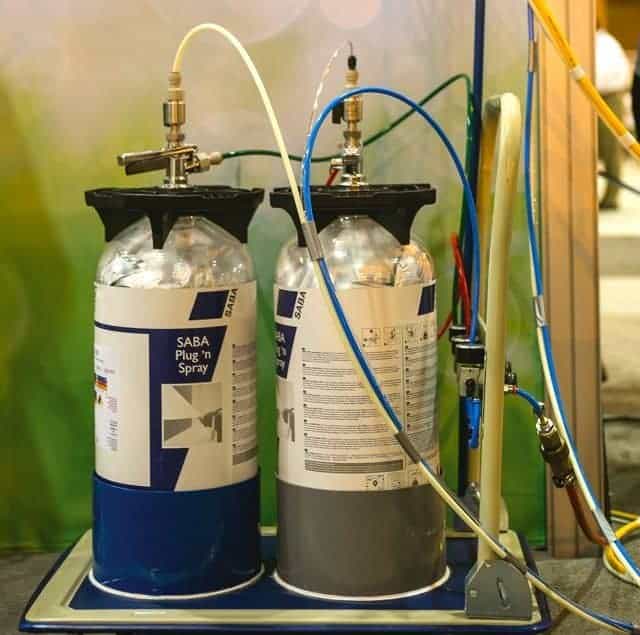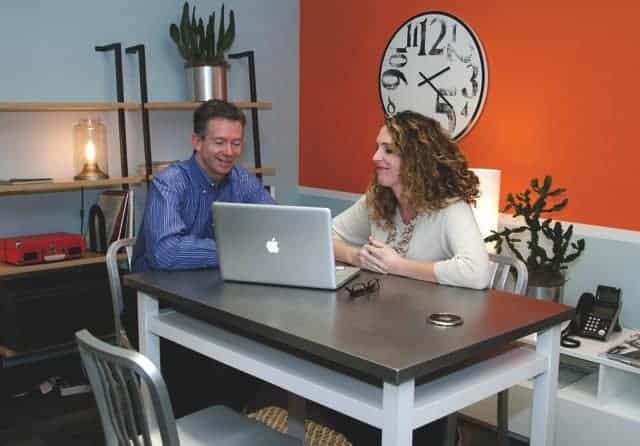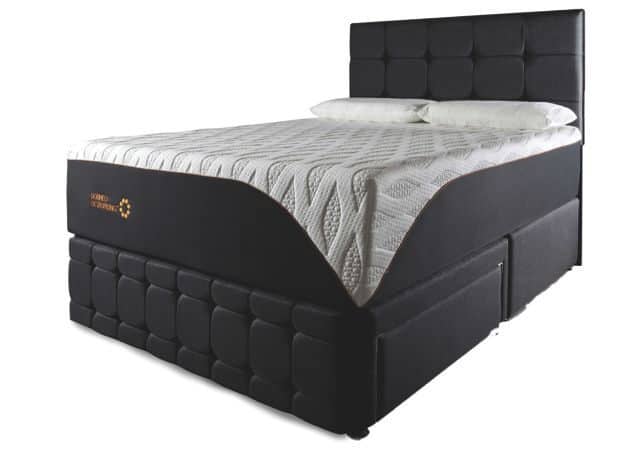How to boost the creativity of your team and create the next BIG thing in the bedding industry

There are many ways to encourage creativity and innovation in the workplace—some are simple, but many require an entirely different outlook and an openness to doing things differently.
At ISPA EXPO in March, keynote speaker Luke Williams offered ideas and suggestions on how to use disruptive thinking to shake things up and bring about true innovation. Williams, author of Disrupt: Think the Unthinkable to Spark Transformation in Your Business, and a professor of innovation at NYU Stern School of Business, suggests in today’s world, innovation and creativity are more important than ever.
“Industry is changing faster than ever before, and we’ve all got to keep up by bringing new ideas into play,” says Williams.
Innovation is risky
“Most companies are innovative when they start,” says Jay Terwilliger, a business innovationist and chief executive officer of Creative Realities. “Over time, (a company) loses that innovative spirit. It’s more about managing a business than creating something new.”
Terwilliger, who has helped companies like Colgate Palmolive, Unilever and Kellogg’s “create and stimulate their innovative culture,” says part of the reason that innovative spirit gets squelched is because change is hard, uncomfortable and risky.
Williams concurs.
“The only times an organization changes are when they’re forced to—when they’re backed into a corner,” he says.
Terwilliger suggests that if innovation is something that you really want, you have to go after it with purpose. Without a compelling case for action, he says, organizations tend to quickly go back to old habits. Having a shared view of the future is also key to fostering change.
“Everybody has to understand it, or they won’t all be pulling in the same direction,” Terwilliger explains.
It’s also important to have a plan with a purpose, and to visibly involve senior leaders. Senior management must be “open-minded to the absurdity of potentially break-through ideas when first presented,” says Terwilliger.
Creativity is not limited to the office
Keep in mind that creativity does not always come when called. We’ve all had that middle-of-the-night brainstorm, or the thought that seems to come out of nowhere. Often, our brains are working through things subconsciously and, sometimes, taking a step back is the most productive thing to do.
“Creative thinking—especially problem solving—rarely happens in a meeting or when answering email,” says Mary Herbenick, an independent communication consultant based in Greensboro, North Carolina. “It happens during conversations. It happens right before you fall asleep, while you’re in the shower, and when you take a hike or engage in activity far away from the office or the manufacturing floor.”
For example, adhesive manufacturer SABA launched a new product at ISPA EXPO that got its start, of all places, in a bar. The patented Plug n Spray uses a disposable pressure tank modeled after a simple design: a beer keg. A SABA employee had an “aha” moment not while brainstorming with fellow employees, but while leisurely sipping a pint. The result was a simple idea that met with a successful launch and gives “big-system performance to the smaller producers,” says President Jim Turner.
Turner says he encourages his employees to think creatively, and to realize that inspiration can come from anywhere.
“Our people aren’t afraid to throw out ‘what-if’ questions,” says Turner. “…You can get in your own way if you keep doing things the way you always have.”
Often, a simple change of scene can help to spark new ideas.

Jim Ross, senior vice president for design and innovation at Simmons, presents the Sleep Insights and Innovation Team’s unique “left brain/right brain” approach to development—part logic, part creativity—at Simmons’ national meeting.
At Serta, Andrew Gross, senior vice president of marketing, says that the company routinely sends its teams to markets, shows and other events around the world in search of new product and marketing ideas.
Even if you don’t have a big travel budget, simply encouraging your employees to take time off, while it may seem counterintuitive, can help feed that innovative spirit. Herbenick, who has spent the last 20 years helping Fortune 500 companies “engage employees and drive results,” says that study after study shows that time away from work fosters creativity, productivity and better health.
“Our latest recession taught people to not take the full amount of paid time off they’ve earned, and employees are afraid to shut down their computers or to turn off their devices while they’re not working,” she says.
So for true creativity bursts and innovative ideas, make sure your employees have enough down-time.
“Reward people for taking their vacation time,” she suggests. “Ban weekend email unless there’s a life-or-death situation. And remember that people are watching you, as leaders, for the cues about how they’re supposed to act at work.”
Even while they’re at work, Herbenick suggests, there are ways to help employees get those creative juices flowing by stepping away from the computer for a few minutes.
“When we move our bodies, we see and experience the ordinary a little bit differently,” she explains. Finding ways to help your team get out from behind their desks and move around, through walking meetings or a group fitness class, will boost employee morale and help your team think more creatively.
Herbenick says if employees are doing their best thinking away from the office and their devices, give them the tools to bring ideas back to the team.
“Years ago, a leader gave each member of our team a small, 79-cent notebook that would fit in a pocket or purse that we used for capturing ideas, questions and other random trains of thought that we could then share as we saw fit,” she says.
Be open to ideas from anyone

Ideas can strike at any time—an employee was inspired to create SABA’s innovative new Plug n Spray, which uses a disposable pressure tank, after looking closely a beer keg in a bar.
Perhaps one of the most important things to do to spark new ideas is to have multifunctional teams that work collaboratively, Terwilliger says.
“You don’t put five marketing guys on a team, because they all see things the same way,” he explains.
Williams suggests that ideas need to meet, mix, mate and mutate, because one person’s ideas mixing with another’s can often create an entirely new—and innovative—idea.
“Ideas aren’t self-replicating organisms,” says Williams.
At manufacturer Dormeo N.A., Dany Sfeir, chief marketing officer for North America, says he allows everyone to participate in product development.
“I take ideas from retailers, sales reps, employees,” he says. “I truly believe that fosters creativity.”
Sfeir says some of the company’s best product ideas have come from listening to employees and retailers.
Frank Hood, chief executive officer and president of Kingsdown, Inc., says his company is “not bashful about bringing all groups into the conversation.”
At Serta, Gross says that while product design and innovation technically fall under merchandising and research and development, the company welcomes ideas from any level and department.
“Some of Serta’s most creative ideas come from internal brainstorming sessions that include employees from multiple departments and agency partners,” he says. “… Additionally, Serta has internal committees made up of individuals from various departments that are tasked with bringing new ideas to leadership.”
Jim Ruehlmann, chief insights and innovation officer at Simmons Bedding Co., says his team is “eclectic and diverse,” and includes mechanical engineers, an electrical engineer, a materials science engineer, chemical engineers, a textile engineer, a marketing major and a self-professed “foam geek.”
“I have someone with 40 years of bedding experience and someone with 18 months on my team,” he says. “We all bring different skills to assess issues and elevate the final product. We’ve built a team composed of intelligent, creative individuals with a mutual respect for one another. We all have different backgrounds, but the one thing (we have) in common is our passionate enthusiasm for innovation. That’s by design—a baseball team of nine first basemen won’t win the game. Our differences produce a creative friction that generates the sparks for great ideas.”
Terwilliger even suggests that while the tendency is to involve people in innovation efforts because of their expertise and experience, companies would be wise to get some new blood in the game.
“Experts see what is,” he says, while those without the experience see new possibilities. “Bring in outsiders—people with new thoughts.”
Sfeir left the bedding industry for seven years and worked in the health and beauty industry, which he credits with giving him new perspective when he returned to bedding.
“We move from one place to another (within the same industry),” he says. “In some ways, that’s good, but I don’t think it fosters as much creativity…. If we keep doing the exact same thing in the bedding industry, we will never get the customer to be excited.”
Making connections
True innovation is rare, and often means stepping out of your comfort zone. Often, it requires a willingness to take a risk with minimal data, says Terwilliger.
“If it’s truly new, and nobody has been doing it, there’s no data out there—there’s no frame of reference,” he explains.

The right environment Jim Ross, senior vice president for design and innovation at Simmons, and Betsy Gardner, director of innovation, think things out in the Sleep Insights and Innovation Team’s workspace, which features non-corporate details such as sofas and brightly colored walls, designed to inspire creativity.
In an age when we’re often reliant on market analyses, data and spreadsheets, this can be challenging. But Williams says that data only goes so far.
“The analysis data is important, but it will only ever get you 50% of the way there,” he says. “The other 50% is human imagination.”
Because truly new ideas are probably so far outside the realm of what we’re used to, they are often easy to dismiss or overlook.
“You’re going to bet on the ideas that you think are intuitively right, and that’s the ideas that you’re most familiar with,” explains Williams.
Terwilliger says we tend to think and ideate in a very narrow band.
“It’s not very often we have a really new idea, and when we do, we laugh—and that’s where the really big ideas come from,” he says. “You have to learn to encourage that ‘stretch-thinking.’ If all you do is think about things that are doable, they’re not new.”
But Terwilliger says it’s important to allow room for what he calls “iterative incubation and execution,” or do, learn, adapt.
“Too many companies fail because they have an idea, they try it, it doesn’t do very well, and they move on,” he explains. “In true innovation, there is failure. It’s very rare that anything comes to life perfect.”
Fail fast and fail cheap is a strategy for failure, says Terwilliger. Instead, he suggests testing an idea quickly and inexpensively, designing the test to learn, adapting the innovation, and testing again.
Terwilliger also suggests that making connections is important in innovation.
“We have to learn how to make connections between something that is happening outside of our main concern—that’s where a lot of creativity comes from,” he says. “…Keep your eyes and ears open and look at what’s happening in other places, and find connections between things that are not normally or have not previously been linked.”
Kingsdown has honed in on the popularity of wearable tech with millennials, for instance, blending technology with sleep in its Sleep Smart bed.
“If you’re going to innovate, you have to innovate with the traditional, garden-variety and then some kind of convergence with qualities from other industries,” says Hood.
And while Sleep Smart is “the most technologically advanced product we’ve ever created,” says Hood, that innovative spirit doesn’t stop there.
“We’re putting critical thought not just into this product, but into every other product,” he says.
At Simmons, Ruehlmann says the company looks for ideas from inside the organization, which he calls “in-novation,” but also tries to blend that with inspiration from outside of the company, which he calls “out-ovation.”
“This blend keeps us in touch with the marketplace to ensure we are meeting consumer and retailer needs,” he explains.
Stop worrying about being right
“Creativity is not sufficient,” says Terwilliger. “Creativity is required and encouraged, but it’s not innovation…. It’s part of what you have to do, but it’s not enough.”

Making connections Kingsdown’s Sleep Smart bed found inspiration in the popularity of wearable tech with millennials today.
There was a time when most people thought creativity was a talent and not a skill, he says; not so anymore.
“What we have found over time is that’s only partially true,” says Terwilliger. “Some people are more talented than others; however, it’s also a skill that can be trained.”
Williams says that to innovate, it’s important to start worrying less about your success rate and more about your experimentation rate.
That also means learning that you don’t have to be successful right away, says Terwilliger.
“The problem with a lot of people in terms of creativity is that since the age of 5 they’ve been taught there’s a right answer and a wrong answer,” he says. “The world is not black and white; it’s multicolored, and there are lots of ways to do anything.”
Rather than trying to be creative, people instead often stop themselves short by asking if something is a “good idea.” Instead of thinking about what the product is or whether it’s a good idea, Terwilliger suggests focusing on divergent thinking with no censorship.
“Get as many ideas out as you can and don’t worry if they’re good or bad,” he says.
It’s not that there are no bad ideas, says Terwilliger, it’s that “sometimes those things we think are bad ideas are stimulants for someone else’s good ideas—the seeds of something really big.”
At Simmons, Betsy Gardner, director of innovation, says that she thinks of innovation as a discipline.
“There’s no such thing as lightening in a bottle or a silver bullet solution,” she says, “but with a thoughtful design process, we can make some pretty extraordinary products come to life.”
The ‘threshold of acceptance’
Once you’ve brainstormed as many ideas as you can, the next step is to look at them all and decide which ones are worth exploring further. Then, says Terwilliger, you brainstorm again, and ask: “How could we make this happen?”
Michael Defranks, vice president of advanced technologies at Simmons, says, “In my tenure, I’ve found that the ‘what-ifs’ often lead to the best answers and solutions.”
Employing what Terwilliger calls “developmental thinking” involves open-minded evaluation. Once you have an idea, and you start asking how to make it happen, “all the killers come out,” he says, and people shoot down ideas, saying they can’t or won’t work.
This kind of practical approach is detrimental to innovation.
“Nothing kills a new idea faster than common sense,” says Williams.
Instead, employees must learn to put those thoughts aside, and learn how to critique in new ways.
Terwilliger says, “People think they can show how smart they are by finding the flaws—but they don’t find how to correct it.”
Terwilliger says that no idea is ever totally perfect or totally worthless; instead, the key is to see if it passes what he calls “the threshold of acceptance.” The challenge, then, is to see if you can make it better than it is.
First, he says, you are only allowed to say what you like about the idea. Then, start looking into what’s holding it back from crossing the “threshold of acceptance.”
“Find your hurdle, but state it as a ‘how to,’” suggests Terwilliger. “How to make this more affordable, rather than saying ‘It’s too expensive.’ Instead of killing something, what you’ve done is invite problem-solving. You’re strengthening an idea; you’re building an idea.”
Model behavior
It’s important to not just encourage this behavior in your employees, but also to use it yourself. Probably the most important thing managers and leaders can do is to model creativity and risk-taking themselves, Herbenick says.
At Simmons, Ruehlmann says that the passion for innovation starts at the top with Chief Executive Officer Gary Fazio and President Tony Smith.
“Both greatly value Simmons’ reputation as an innovation leader in the bedding industry and encourage us in our efforts to think outside of the box in terms of new product development,” says Ruehlmann.
This isn’t always easy for leaders or managers, who can feel threatened when employees challenge the way things are done. But change and innovation only come about when questions are asked.
Williams challenges us to ask, “How many of the decisions you’re operating on were made in a different age?”
In today’s economy, especially as a new generation of consumers raised on technology comes of age, we need to be changing and innovating just to keep up. If you want your employees to think creatively and take risks, you must act accordingly.
“As a leader, do you try new things and share them whether they succeed or fail?” asks Herbenick. “Do you celebrate or cringe when you hear employees say ‘I don’t understand why we do X this way’ or ‘I’ve always wondered about Y….’? Traditional suggestion boxes aren’t going to cut it anymore—leaders need to model vulnerability if they’re going to demand it from others.”
Fashion-forward innovation

Dormeo has stepped outside the white rectangle to bring details with feminine appeal, such as rounded edges, a wavy pattern and a black-and-orange color palette.
Many manufacturers have pushed the envelope lately when it comes to combining fashion and bedding. While for many years the thought was to keep things simple (translation: white rectangle) because the bed would be covered up, today’s cutting-edge mattress manufacturers have realized that a bed still needs to attract a customer’s attention to stand out from the crowd.
“…The bedding industry is getting more innovative, creative and fashion-forward,” says Andrew Gross, senior vice president of marketing for Serta. “Consumer expectations are evolving because today’s consumer is more engaged and empowered when it comes to purchasing a mattress. The expectations are high, and manufacturers are responding.”
And more and more manufacturers in this male-dominated industry are realizing that it’s often the women who are making the buying decisions.
“While it’s a utilitarian product, it starts out from an emotional perspective,” says Frank Hood, chief executive officer and president of Kingsdown, Inc. “We need to ask ourselves, ‘How does this look in the sea of 48 rectangles on the floor?’”

Kingsdown recently partnered with designer Joyce Henley for her fashion-forward, avant-garde approach that takes inspiration from women’s fashion, as in this Parisian-themed border fabric.
Hood says Kingsdown recently partnered with designer Joyce Henley for her fashion-forward, avant-garde approach that took looks inspired from women’s fashion and blended them with different textures for a unique look.
Dany Sfeir, chief marketing officer, North America, for Dormeo N.A., says his company also looked at women’s reactions to mattresses.
“At the end of the day, women buy this product, and we need to talk to women,” he says. “The white rectangle was not speaking to them.”
Dormeo responded by creating a product that features the traditional functionality of a mattress, but includes details with feminine appeal, such as rounded edges, a wavy pattern and a black-and-orange color palette.
“We gave it a different look than any mattress out there,” says Sfeir. “…At the end of the day, we need something unique—something that stands out. It helps our customers see us as a different product than anything else out there.”




